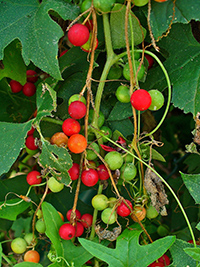Table of Contents
The young buds on the wild hops plant can be consumed in the spring as if they were asparagus. However, be aware of its root and red fruit, which are highly poisonous. The fruit still hangs until the Fall, after the rest of the plant has dried. Not even birds consume it. It is worth distinguishing wild hops from sasparilla since their fruit is edible and has medicinal properties. Sasparilla has thorns on its stem and heart-shaped leaves.

Wild Hops Plant Scientific Facts
- Scientific synonym: Bryonia dioica Jacq.
- Other names: Red bryony, devil’s turnip, wild vine, wild white vine.
- French: Bryone.
- Spanish: Brionia.
- Environment: It is common in southern and Central Europe forests and bushes, especially near river banks. It is also found in America.
- Description: This is a climbing plant of the Cucurbitaceae family, growing to 3 m high. Its leaves have five lobules and spiral tendrils grow opposite them, sticking to other plants and trees. It has white or bluish flowers, and the fruit is a red berry.
- Parts of the plant used medicinally: The root.

Healing Properties and Warning
The wild hops plant root is large, turnip-shaped, and can grow to the size of a human head. It is very irritating to the skin. This root contains a resin and an alkaloid (bryonine), which give it drastic purgative properties. In ancient times, it was used for brain congestion and edema; however, it is no longer used since it produces intense diarrhea. At present, there are other milder remedies.
WARNING! This plant’s red berries are dangerously poisonous and can even cause death. In the case of poisoning (unlikely to occur since these berries are irritants and practically inedible), vomiting is required. Then, administer charcoal and move the poisoned person to a hospital.
Wild Bryony

White bryony, also called wood vine, is another species of the same botanical family. It has properties similar to those of wild hop plants. It is called white bryony because its flowers are white and its berries are black.
How to use Wild Hops
- Root. It has traditionally been used as a drastic laxative, but it is no longer used because it produces too energetic effects.
Frequently Asked Question
I’ve heard the wild hops plant has anti-inflammatory effects. How strong are these effects, and what conditions might they help with?
Research supports wild hops’ anti-inflammatory properties. Studies suggest potential benefits in osteoarthritis, rheumatoid arthritis, and inflammatory bowel disease (IBD).
Can the wild hops plant help with pain management?
There’s evidence for Bryonia dioica’s analgesic (pain-relieving) effects. Studies indicate potential use in managing pain associated with arthritis, headaches, and muscle soreness.
Does the wild hops plant have any effect on anxiety or sleep?
Preliminary research suggests possible calming and sleep-promoting effects.
Are there any studies on the wild hops plant for respiratory health?
Traditionally, wild hops have been used for respiratory issues. Some studies suggest potential benefits in reducing coughs and easing symptoms of asthma and bronchitis.
Can the wild hops plant interact with medications I’m already taking?
Yes, wild hops could interact with several medications, including blood thinners, diabetes medications, and diuretics. It’s crucial to check with your doctor before using wild hops alongside other medications.
What are the common side effects of wild hops?
Wild hops can cause gastrointestinal upset like nausea, vomiting, and diarrhea. In high doses, it can be toxic.
Where can I find reliable information on the safe dosage of wild hops?
Due to potential toxicity, it’s strongly recommended to consult a qualified herbalist or healthcare professional for personalized dosage recommendations. Avoid self-dosing.
Are there any forms of the wild hops plant that are safer or easier to use than others?
Consulting a professional is essential regardless of the form. However, under guidance, homeopathic preparations of wild hops may have a lower risk profile than concentrated extracts.
Is wild hops safe for pregnant or breastfeeding women?
No, wild hops are not considered safe for pregnant or breastfeeding women.
Are there any known contraindications for using wild hops?
Yes, people with certain medical conditions, such as ulcers, gastritis, or kidney problems, should avoid using wild hops.
DISCLAIMER: All content on this website is presented solely for educational and informational objectives. Do not rely on the information provided as a replacement for advice, diagnosis, or treatment from a qualified medical expert. If you are pregnant, nursing, or have any preexisting medical concerns, talk to your doctor before using any herbal or natural medicines.
REFERENCES
- George D. Pamplona-Roger, M.D. “Encyclopedia of Medicinal Plants.” George D. Pamplona-Roger, M.D. Encyclopedia of Medicinal Plants. Ed. Francesc X. Gelabert. vols. 2 San Fernando de Henares: Editorial Safeliz, 2000. 490. Print.
- Anti-inflammatory and anti-arthritic effects of Bryonia dioica: https://www.ncbi.nlm.nih.gov/pmc/articles/PMC8363226/
- Evaluation of the analgesic and anti-inflammatory activity of ethanolic extract of Bryonia laciniosa seeds: https://www.ncbi.nlm.nih.gov/pmc/articles/PMC9788634/
- Anxiolytic-like effect of the methanolic extract of Bryonia alba L: https://pubmed.ncbi.nlm.nih.gov/22290205/
